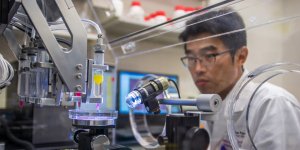Science News

Astronomers have used ALMA to detect a huge mass of glowing stardust in a galaxy seen when the Universe was only four percent of its present age. »

Scientists from the Universities of California and North Carolina, with several other universities in the United States and Canada, report a strong correlation between abnormal distribution of cerebrospinal fluid in infants and later development of autistic symptoms. »

A research project conducted by the Agroenergy division of the Brazilian Agricultural Research Corporation has identified species of microalgae that can be grown in liquid waste from agroindustrial processes to provide renewable raw materials. »

The combination of prolonged hot spells with poor air quality greatly compounds the negative effects of each and can pose a major risk to human health, according to new research. »

A genetic “mutational meltdown” helped push the woolly mammoth toward extinction, according to a new study. »

There's a new record holder for brightest pulsar ever found -- and astronomers are still trying to figure out how it can shine so brightly. »

People diagnosed with attention deficit hyperactivity disorder have smaller brain volume than those without the disorder. »

NASA's Dawn mission has found evidence for organic material on Ceres, a dwarf planet and the largest body in the main asteroid belt between Mars and Jupiter. »

A scientist who found fame recovering a meteorite that crashed into Russia in 2013 has found 13 kilograms of meteorite-like material in Iran’s Lut desert. »

For decades, astronomers have tracked black holes with masses millions of times that of the sun, as well as those with tens of solar masses. »

Scientists from the Stanford University School of Medicine announced the invention of a new diagnostic tool that can sort cells by type: a tiny printable chip that can be manufactured using standard inkjet printers for possibly about one U.S. cent each. »

Malaria-carrying mosquitoes are becoming resistant to the insecticide used in bed nets to prevent the disease. Researchers say it is important to stay ahead of the resistance to avoid what they are calling a public health catastrophe. »

Soccer players who head the ball a lot are three times more likely to have concussion symptoms than players who don't head the ball often, according to a new study. »

It is almost impossible to eradicate Aedes aegypti mosquitoes, the vector for dengue, zika, chikungunya, and yellow fever, said the chair of Fundação Oswaldo Cruz (FIOCRUZ), Dr. Nísia Trindade. »

Scientists at the University of Florida Institute of Food and Agricultural Sciences and their partners have found a way to get tomatoes to produce the compounds that make them more flavorful. »

For the first time, chemists at the University of Illinois at Chicago have used a path-breaking optical imaging technique to pinpoint cholesterol's location and movement within the cell membrane. »

Between 1985 and 2015, 219,735 hectares (2,197 km2) of the Atlantic Forest remnants went through a process of regeneration in nine of the 17 Brazilian states that have the forest. »

Scientists from Yale University report they managed to trigger instinctive hunting behavior in mice using optogenetics, a manner of priming cells within an organism's brain to switch on when exposed to a laser. »

Researchers at the National Institutes of Health found that the blood protein tau could be an important new clinical biomarker to better identify athletes who need more recovery time before safely returning to play after a sports-related concussion. »

Children of obese parents may be at risk for developmental delays, according to a study by researchers at the National Institutes of Health. »

Private space exploration company SpaceX has conducted its first successful launch since the explosion of a rocket on the launchpad in September. »

The Amazon lost 7,989 square kilometres of rainforest between August 2015 and July 2016, according to a survey published by the Amazon Environmental Research Institute based on late 2016 government data. »

There could be some dramatic changes to the night sky if astronomers are correct in their observations. »

Monster black holes sometimes lurk behind gas and dust, hiding from the gaze of most telescopes. But they give themselves away when material they feed on emits high-energy X-rays that NASA's NuSTAR mission can detect. »

A joint research team from the University of Calgary, American Museum of Natural History, and Florida State University announced that the eggs of non-avian dinosaurs such as the duck-billed dinosaur took as long as six months to hatch, far longer than had previously been believed. »

Researchers identified a new insecticide for mosquitoes that inhibits a potassium channel to block kidney function. »

According to a study published on Monday in the Proceedings of the National Academy of Sciences, the cheetah (Acinonyx jubatus), is down to 7,100 individuals remaining worldwide, most of them in Africa and, rarely, in Asia. »

Researchers restored recently “set aside” memories by magnetically stimulating the unique patterns of brain activity that were originally provoked. »

At first glance, Ceres, the largest body in the main asteroid belt, may not look icy. Images from NASA's Dawn spacecraft have revealed a dark, heavily cratered world whose brightest area is made of highly reflective salts -- not ice. »

A sensor array off the Pacific Northwest coast has captured the cracking, bulging and shaking from the eruption of Axial Seamount, a nearly mile-high undersea volcano, in more detail than ever before. »

A satellite developed by junior high school children from Ubatuba, São Paulo state, was launched to the International Space Station (ISS) from Tanegashima Space Center, Japan, on Friday (Dec. 9). »

The next time you’re hungry for a snack, you may want to grab a handful of nuts, as new research suggests they lower the risk of heart disease, cancer and other diseases. »

The present-day thinning and retreat of Pine Island Glacier, one of the largest and fastest shrinking glaciers of the West Antarctic Ice Sheet, may have already been underway as early as the 1940s, according to findings from an international research team led by the British Antarctic Survey. »

GOES-R, the first of NOAA’s highly advanced geostationary weather satellites, lifted off from Cape Canaveral, Florida, at 6:42 p.m. on November 19. »

Babies whose mothers were infected with the Zika virus during pregnancy will be monitored for up to 3 years, even if they have not reported any symptom at birth. »

In October, La Niña’s presence started to be felt, as global temperatures cooled from the record warm conditions experienced earlier in the year. »

Researchers found that neurons activated by the “social hormone” oxytocin lessen anxiety in male mice, but not females. »

The number of discovered near-Earth asteroids (NEAs) now tops 15,000, with an average of 30 new discoveries added each week. This milestone marks a 50 percent increase in the number of known NEAs since 2013, when discoveries reached 10,000 in August of that year. »

2016 TB57 is a small asteroid that will come closest to Earth on Oct. 31 at just beyond five times the distance of the moon. »

Two new studies by researchers at NASA and the University of California, Irvine, detect the fastest ongoing rates of glacier retreat ever observed in West Antarctica and offer an unprecedented direct view of intense ice melting from the floating undersides of glaciers. »

A network of diverse Internet-connected devices targeted the Dyn domain registration service provider. It took down Dyn clients, including several popular websites such as Twitter, Netflix, Spotify, Reddit, New York Times, and Wired. »

Scientists are studying the skeleton of an ancient sea monster. It was discovered in Scotland 50 years ago, but it wasn’t until more recently -- using modern fossil extraction methods — that the bones could be pulled out of hard rock. The previously unknown reptile lived in the oceans during the time of the dinosaurs. »

With the help of two young patients with a unique neurological disorder, an initial study by scientists at the National Institutes of Health suggests that a gene called PIEZO2 controls specific aspects of human touch and proprioception, a “sixth sense” describing awareness of one’s body in space. »

Researchers identified brain cells responsible for boosting memory retention in mice when they have novel experiences. »

It’s small, it’s hot, and it’s shrinking. New NASA-funded research suggests that Mercury is contracting even today, joining Earth as a tectonically active planet. »

A new image of comet 67P/Churyumov-Gerasimenko was taken by the European Space Agency's Rosetta spacecraft shortly before its controlled impact into the comet's surface on Sept. 30, 2016. »

The puzzling appearance of an ice cloud seemingly out of thin air has prompted NASA scientists to suggest that a different process than previously thought -- possibly similar to one seen over Earth's poles -- could be forming clouds on Saturn's moon Titan. »

A group of scientists of the Assam Agricultural University of Assam, India has claimed the Bhut Jolokia, which was once recorded as the hottest chilli in the world in the Guinness World Records, is losing its characteristic hotness with time. »
Researchers used computer simulations to screen millions of molecules for opioid-like pain-relieving properties. The analyses allowed scientists to create a molecule that effectively alleviates pain in mice, but with fewer side effects than the opioid morphine. »
Supermassive black holes, with their immense gravitational pull, are notoriously good at clearing out their immediate surroundings by eating nearby objects. When a star passes within a certain distance of a black hole, the stellar material gets stretched and compressed -- or "spaghettified" -- as the black hole swallows it. »


